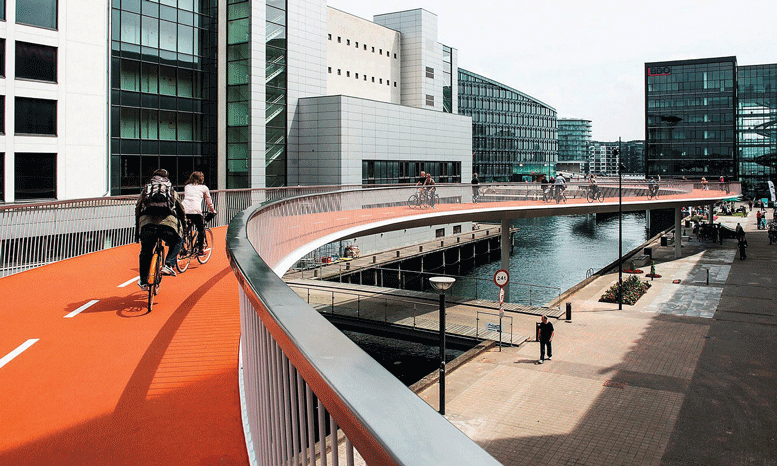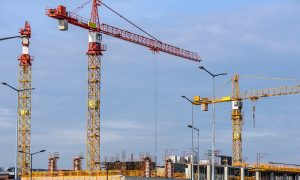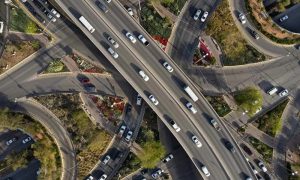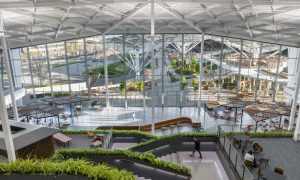Smart cities: From driverless cars to sustainable design
Many ingredients will help form the cities of the future

According to a report by the International Electrotechnical Commission, urban spaces are said to grow by almost 150,000 every day, due to migration and births. Between 2011 and 2050, the world’s population is expected to rise by 72% and the population share in urban areas to 67%.
This rise in population and the resulting need for a paradigm shift in urban development and design has led governments around the world to steadily move towards making cities smarter, increasing interconnectedness, simplifying commutes and integrating technology into almost every aspect of a citizen’s life.
We’ve already seen power players like Google revolutionise the automobile industry with its driverless cars; smartphones are becoming more intelligent every year; what can we expect from the infrastructure of a future smart city?
Master planning
Addressing the master planning aspect of a smart city James Kirkpatrick, global director of master planning at AECOM, says that for a smart city, a deep understanding of physical networks such as utilities and transit is needed. This knowledge then needs to be married to social behaviour, macro-economics and environmental issues to create a balanced smart response.
“Scale and density go hand in hand in being critical success factors for a smart city. Ultimately, city development is guided by the exchange between people, and compact, dense urban development is a fundamental element to achieve this in an efficient manner.
“Getting fundamental systems in place and working together will achieve a lot more than large investments in technology that may be on flawed systems. Also, cities that create robust planning and spatial frameworks that address wide-ranging issues, from land planning through urban agriculture to urban resiliency, will be well placed to achieve smart outcomes.”
With this kind of detailing of infrastructure, equal investments and innovation from both the private and public sector will be needed. Kirkpatrick says, “There needs to be a balance between private and public sector. There is a general impression that the private sector leads the way in innovation for smart initiatives, but the rationale and demand for this innovation is driven by the public sector.”
“Dubai has made the smart city initiative a core principle of its development, and that message is resonating through the private sector. A project like the Dubai Smart Palm, a simple shade structure that provides Wi-Fi and mobile charging, as well as being an information centre, seems small in stature but represents a much bigger idea for Dubai as a city, and its global aims for being a smart city, by providing facilities accessible to everyone.”
Technology is also increasingly helping the master planning process. Kirkpatrick says, “Technical tools that are being developed allow us to better understand, map, model and create solutions for cities. Big sources of data are being developed, refined and specialised that will be phenomenal tools in the near future to guide city development. These tools will help to plan for housing needs, resolve traffic issues, plan for strategic investment and essentially make city development an increasingly certain process.”
Connectivity and Transportation Networks
Another fundamental feature of a smart city is accessibility, and in today’s day and age that means easy accessibility. Cities have always evolved around transportation networks, and in today’s increasingly globalised world, easy connectivity within city limits and externally is crucial.
Talitha Fabricius, associate director at Ramboll Middle East, is of the opinion that a significant realm of implementation and effectiveness of smart city systems is in transportation, comprising energy-intensive systems that make cities work. Transportation systems and corridors are the lifelines of cities and largely define their effectiveness, character and economic progress.
“Efficient public transport systems with wide networks and multi-modal interchanges are key to the success of smart cities. These address the universally accepted objectives of reduced energy consumption, effective mass transit and efficient use of public space. Connectivity in terms of the various public transport modes and their inter-connectivity are therefore crucial for efficient city functioning,” says Fabricius.
“Creating a street hierarchy and network and providing alternative routes for motorists can be effective, making alternative forms of transit more convenient, cost-effective and attractive and providing coverage across the entire city. Also, paying as much attention to the bicycle and pedestrian network as to the roadway system is important.”
Fabricius goes on to suggest that designing block sizes small enough for people to have short, convenient travel paths to their destinations goes a long way. “Creating connections through blocks and public passageways through buildings that are for pedestrians and cyclists only should be considered.”
Other innovations expected to improve connectivity and transport systems in a smart city include Uber-type technology for driverless electric vehicles, says Fabricius, and greater use and provision of space-saving automated car parking systems at key transit nodes will work well too.
Kirkpatrick agrees that driverless cars will not only revolutionise the automobile space but also play a role in defining a smart city’s road infrastructure. “One concept that is emerging that I think will change city development in the near future is the advent of driverless cars. These are being tested on streets already, and being used at remote work-sites such as mines.”
“Their impact on cities is already on the agenda of city planners, to see how and what impact there will be on city form. I think there will be a gradual adoption of this technology that could lead to changes in city design, perhaps we see less parking, as driverless cars can circulate to other locations, which would lead to a different streetscape, and building form and typologies could change to reflect changing needs for car ownership.”
Sustainable Design
Sustainability in design is imperative for a city to truly earn the ‘smart’ tag. Materials used in construction and infrastructure especially need to be even more environment friendly and keep the carbon footprint as low as possible.
Abeer Manneh of Woods Bagot says that sustainable design consideration is a core element in achieving a liveable sustainable built environment. “At one end, the urban design approach shall influence reductions in CO2 emissions in transportation infrastructure through means of transit-oriented design (TOD), designing a pedestrian-friendly, safe and walkable environment.”
“To give an example, in a smart city you would expect the citizen to have information on where is the nearest bus stop, and when is the next bus expected to arrive via mobile application. However, to encourage the citizen to use the bus, the pedestrian path should be safe, the stop should be within a walkable distance, and the outdoor conditions should be relatively comfortable, e.g. provision of shaded walkways. This would result in less CO2 emissions by using public transport rather than single-occupancy vehicles, reduce fuel consumption, have more lively districts and promote healthier living.”
In terms of material selection, Manneh says the choice should be towards sustainable materials that are re-usable, recyclable or produced with recycled content. “There are also innovative sustainable products and materials that could contribute positively to the environment, such as bio-concrete that has capabilities to purify polluted air, self-healing concrete that uses bacteria to heal cracks when the building is ageing, bio-bricks that have very low embodied carbon and could be produced on-site. It is imperative to note that the options we have these days are great, and due diligence is required to select the most suitable and sustainable materials within a project’s context.”
“On a building level, green technologies such as water and energy metering and monitoring systems, efficient irrigation systems such as sub-surface irrigation, localised treatment for organic waste, localised wastewater treatment – such as reed-beds that could be integrated into the landscape strategy and the use of greywater within the building – and irrigation are few examples on how individual buildings can contribute to a more sustainable neighbourhood.”
Another thing that buildings could also integrate are electric charging stations for e-bikes and electric cars that could also connect to the neighbourhood network, says Manneh. Other technologies like integrated renewable systems will also play a positive role in shifting buildings to become regenerative developments – positive energy buildings.
Technology
Of course, no smart city is complete without the integration of technology in every aspect of the built environment. Nicolai Solling, director of technology services at Help AG, is of the opinion that Google’s definition of a smart city highlights just how important the role of technology is in a smart city.
“The integration of technology with traditional building design must take place from the onset of the project. New urban renewal projects have to focus around integrating information and communication technologies [ICT] into the physical building itself, so that when completed, the structure has a ready platform for the deployment of technologies essential to connectivity, efficiency and productivity. Technology is already being leveraged to streamline construction itself with applications in communication, design, supply chain and logistics, project planning and management, and others.”
For any smart city to function well, active participation and communication is required from participants in the government, construction industry and IT industry, to find integrated solutions to the existing barriers in our cities.
Soling explains, “To build or transform into a smart city, a consortium of regulatory bodies, construction companies and real estate developers, IT organisations and telecom providers needs to be formed. This is because strategy is an area that needs to be addressed so that all the stakeholders are to be on the same page. Guided by government frameworks, these industry majors must correctly align their long-term goals.”
Solling also breaks down the investment we are likely to see for the advancement of technology in smart cities. “IDC, a leading IT research firm, has predicted that ICT spending in the Middle East and Africa [MEA] region will top $270 billion by the end of this year and a lot of this investment will be in technology areas that are seen as being essential to smart cities. Dubai Municipality alone has allocated AED 3 billion to sustainability and smart city projects for 2015, so clearly there is a lot of investment in this domain.”
Challenges
As with anything new, there will be plenty of challenges, Kirkpatrick notes. “One issue with smart city development is that you often see attempts to try it from scratch on vacant sites, as opposed to integration or enhancement of existing urban fabric. This is an immediate challenge to achieving smart outcomes, because although you have a blank canvas to work with, city building is a multigenerational task. The scale of the endeavour of creating smart cities from scratch often leads to abandoned dreams.”
From an IT perspective, Solling notes that while making services available to citizens via web and mobile channels is a core concept for business in a smart city, this gives hackers an incredibly large number of targets. “Attacks such as distributed denial of service [DDoS], or worse still a cyber-attack on the IT systems of essential utilities such as electricity and water, could cripple the smart city.”
Conclusion
All in all, the next-generation citizen has a lot to look forward to in terms of easier living, commute options and e-services. Moreover, in terms of future proofing smart cities to prevent them from becoming obsolete, Kirkpatrick notes that cities are remarkably resilient.
“Old cities like Rome, Paris and London with their narrow carriageways have adapted to an automobile-dependent culture and have been able to integrate fibre optics and other new infrastructure networks into their physical infrastructure. I think the lesson is that there is enormous capacity for change in cities, as long as the basic structure is not too complicated.”

























